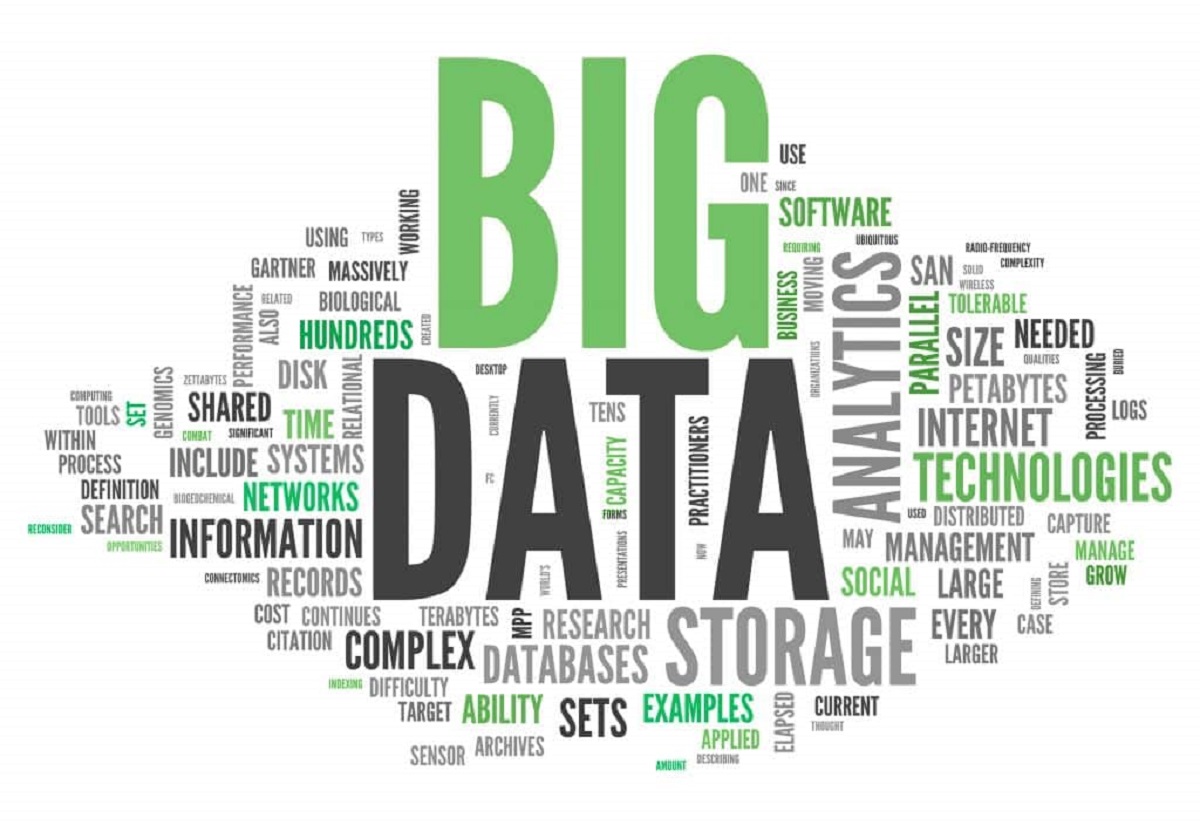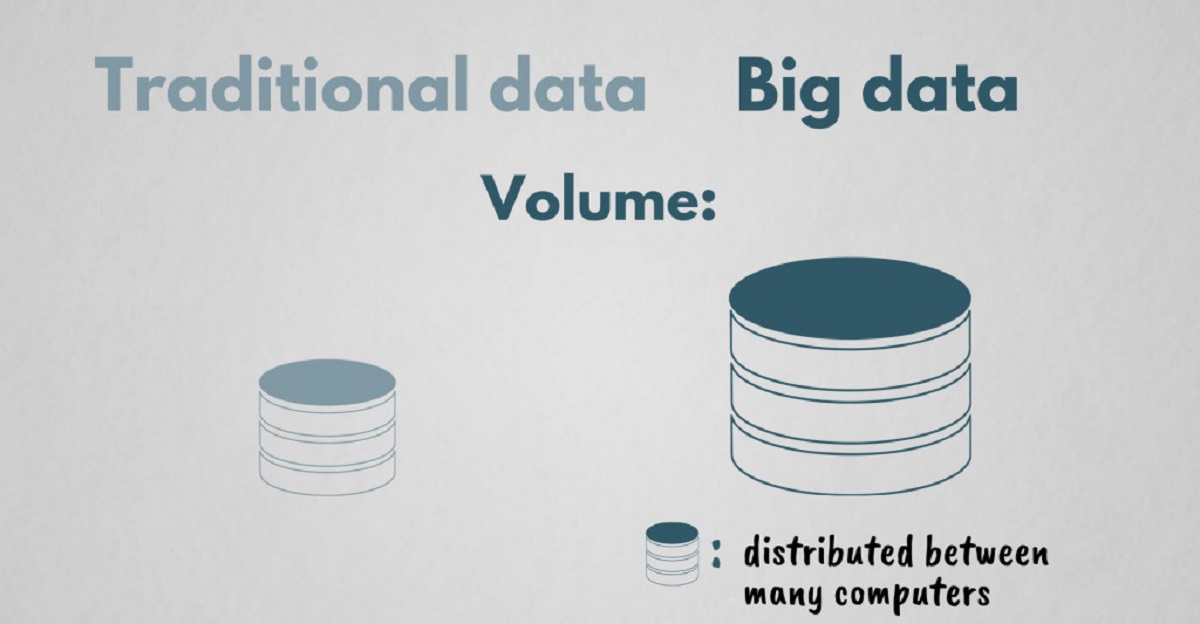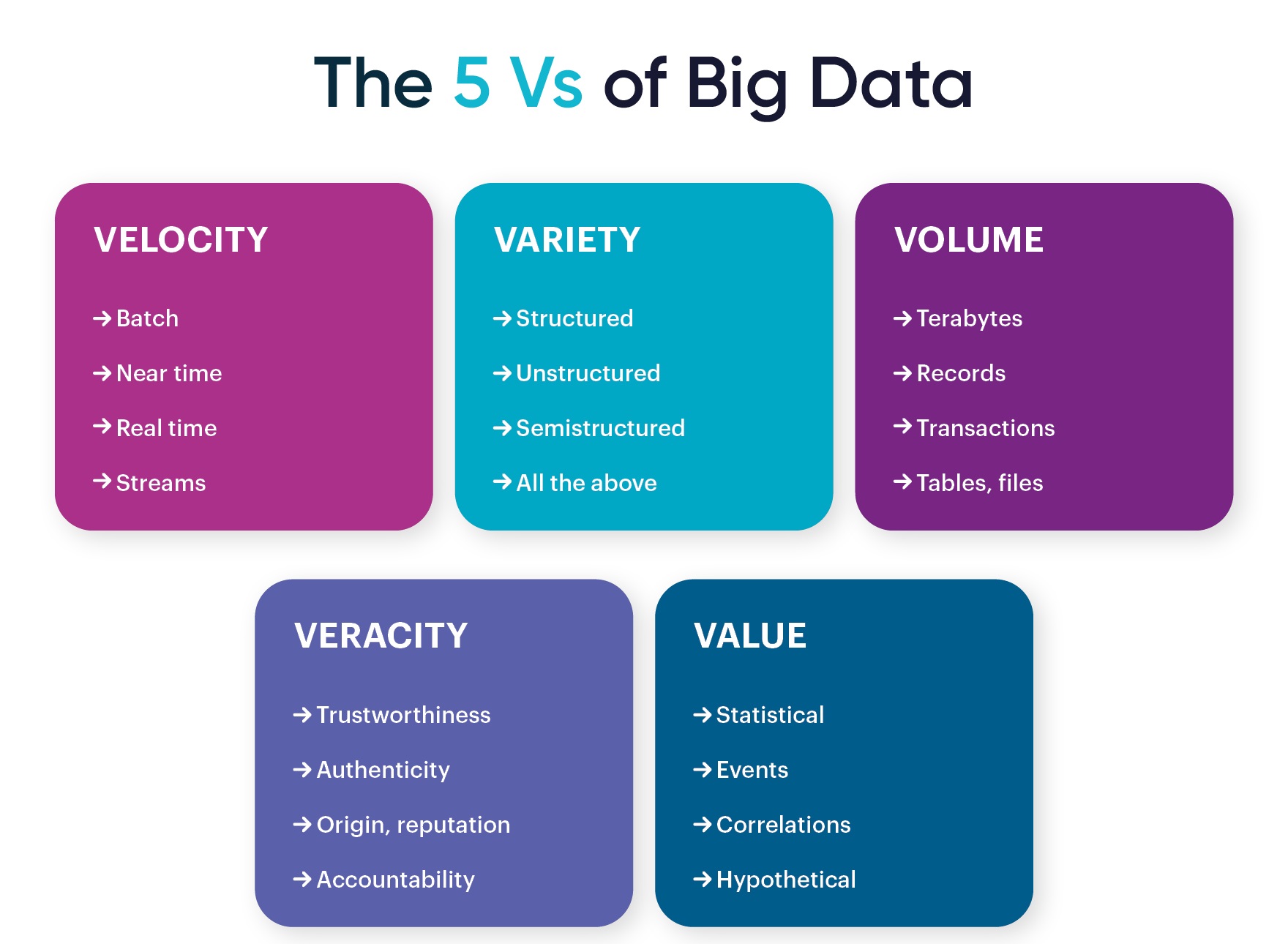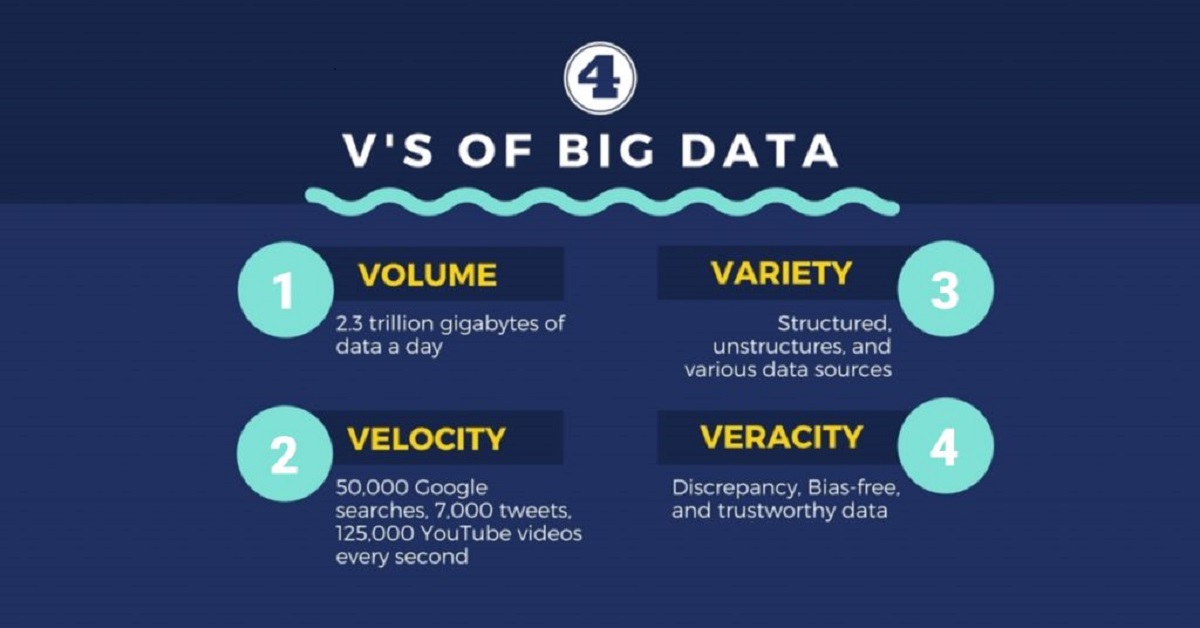Introduction
Welcome to the exciting world of big data, where vast volumes of information are generated, analyzed, and utilized to gain valuable insights and drive decision-making. In this digital age, businesses and organizations have access to an unprecedented amount of data from a myriad of sources. However, the quality and accuracy of this data, known as veracity, are crucial to ensure its reliability and usefulness.
In the context of big data, veracity refers to the reliability and trustworthiness of the data. With the increasing volume and variety of data being generated, veracity has become a significant concern. Poor data quality can lead to incorrect analyses, flawed insights, and ultimately, misguided business decisions.
The importance of veracity in big data cannot be understated. Without accurate and trustworthy data, the insights gained from analyzing big data may be misleading or unreliable. Inaccurate data can lead to significant financial losses, damaged reputations, and missed opportunities.
Ensuring veracity in big data poses unique challenges. The sheer volume of data can make it difficult to identify and address inaccuracies. Data may be obtained from various sources, such as social media platforms, IoT devices, or online transactions, each with its own potential biases and inaccuracies. Data may also be incomplete, inconsistent, or involve duplication. Additionally, the velocity at which data is generated can further complicate the task of validating and verifying its accuracy.
Despite these challenges, there are strategies and tools available to improve the veracity of big data. These may include data validation processes, data cleansing techniques, and data integration methods. By implementing these strategies, organizations can enhance the reliability and quality of their data, thus increasing the accuracy and trustworthiness of their analyses and decision-making.
In this article, we will explore the importance of veracity in big data and delve into the challenges it presents. We will also discuss various strategies and technologies that can be used to improve veracity and examine real-world examples of organizations effectively managing veracity in their big data initiatives.
What is Veracity?
In the realm of big data, veracity refers to the reliability and trustworthiness of the data being analyzed. While the concept of data quality is not new, the scale and complexity of big data make veracity a critical factor in obtaining accurate and meaningful insights.
Veracity is concerned with the accuracy, completeness, consistency, and reliability of the data. It involves assessing the authenticity and origin of the data, as well as evaluating its relevance and appropriateness for the analysis at hand. In simpler terms, it is about ensuring that the data is true, reliable, and fit for purpose.
With the exponential growth of data sources and the ever-increasing velocity at which data is generated, maintaining veracity has become a formidable challenge. Data can be obtained from a variety of sources, such as social media platforms, online transactions, sensors, and other IoT devices. Each source has its own potential biases, inaccuracies, and inconsistencies, which can affect the overall veracity of the data.
Veracity goes beyond just assessing the accuracy of the data. It also involves evaluating the context in which the data was collected, understanding any limitations or biases, and determining the extent to which the data can be trusted for making informed decisions.
For example, consider a scenario where an organization is analyzing customer feedback data collected from social media platforms. Veracity would involve assessing the credibility of the sources from where the data was collected, the authenticity of the feedback, and any potential biases or misinterpretations that may arise from analyzing social media data.
Veracity is not a one-time assessment; it is an ongoing process. Data may change, new sources may emerge, and previously trusted data may become outdated or unreliable. Therefore, organizations need to continually monitor, validate, and verify the veracity of their data to ensure the accuracy and reliability of their analyses.
In the next section, we will explore the importance of veracity in the realm of big data and how it impacts decision-making and business outcomes. We will also discuss the challenges organizations face in ensuring veracity and the strategies they can adopt to improve the reliability of their big data initiatives.
The Importance of Veracity in Big Data
Veracity is a crucial aspect of big data analytics, as it directly impacts the quality and reliability of the insights derived from analyzing large volumes of data. The importance of veracity in big data goes beyond just ensuring the accuracy of the data – it influences decision-making, business outcomes, and overall organizational success.
First and foremost, veracity plays a vital role in informed decision-making. Inaccurate or unreliable data can lead to faulty insights and misguided decisions. When analyzing big data, organizations rely on the accuracy and trustworthiness of the data to identify patterns, trends, and correlations. Without veracity, decision-makers may be misled into making choices based on erroneous or incomplete information.
Veracity also impacts the credibility and trust in the insights generated from big data analytics. In an era where data-driven decision-making is becoming increasingly prevalent, organizations need to have confidence in the results of their analyses. By ensuring veracity, organizations can establish a foundation of trust and enhance their reputation as reliable and knowledgeable entities.
Furthermore, the importance of veracity extends to risk management and compliance. Many industries, such as finance, healthcare, and cybersecurity, have strict regulations and requirements regarding data accuracy and privacy. Failure to ensure veracity can lead to legal consequences, fines, and reputational damage. By prioritizing veracity, organizations can mitigate risks and ensure compliance with industry regulations.
Veracity also impacts the efficiency and effectiveness of data-driven processes. When the data being used is reliable and accurate, organizations can confidently automate processes, develop predictive models, and implement machine learning algorithms. This, in turn, leads to improved operational efficiency, enhanced customer experiences, and increased competitive advantage.
Moreover, the importance of veracity lies in its ability to uncover hidden insights and reveal actionable information. By ensuring the quality and trustworthiness of the data, organizations can uncover valuable insights that were previously hidden or overlooked. These insights can drive innovation, identify new business opportunities, and improve overall performance.
In summary, veracity is a fundamental aspect of big data analytics that underpins the reliability, credibility, and usefulness of insights derived from analyzing large volumes of data. By prioritizing veracity, organizations can make informed decisions, mitigate risks, maintain compliance, improve efficiency, and uncover valuable insights that can contribute to their overall success and competitiveness.
Challenges in Ensuring Veracity
Ensuring veracity in big data comes with numerous challenges. The sheer volume, velocity, and variety of data create complexities that organizations must overcome to maintain the accuracy and reliability of their data-driven insights. Below are some key challenges faced in ensuring veracity:
1. Data Quality: Big data is often sourced from multiple streams and platforms, leading to potential issues with data quality. Inaccurate, inconsistent, or incomplete data can significantly impact the veracity of the insights derived from the analysis. Cleaning and validating the data to ensure quality is therefore crucial.
2. Data Integration: Integration of diverse data sources can be challenging, as each source may have its own structure, format, and quality. Bringing together data from multiple sources while maintaining accuracy and consistency can be a complex task that requires careful cleansing and transformation.
3. Bias and Inaccuracy: Data collected from different sources may have inherent biases or inaccuracies due to various factors, including sampling biases, misreporting, or data collection errors. Identifying and mitigating these biases is essential to ensure veracity in the analysis.
4. Data Governance: Establishing proper data governance practices is crucial to ensure veracity. Organizations must have clear policies and frameworks in place to manage data quality, data access, data security, and privacy. Failure to implement robust data governance practices can compromise the accuracy and trustworthiness of the data.
5. Data Security and Privacy: The sensitivity and confidential nature of certain data can pose challenges in ensuring its veracity. Organizations must prioritize data security and compliance with privacy regulations to protect the integrity and confidentiality of the data they collect and analyze.
6. Scalability: With the exponential growth of data, ensuring veracity at scale becomes a challenge. The ability to validate and verify large volumes of data in real-time or near real-time requires sophisticated tools, technologies, and infrastructure.
7. Lack of Data Literacy: Veracity challenges can also arise from a lack of data literacy within organizations. Without a proper understanding of data quality and veracity, individuals may misinterpret or misuse the insights derived from big data analytics, leading to faulty decision-making.
Overcoming these challenges requires a comprehensive and proactive approach. It involves implementing robust data quality management processes, investing in data governance frameworks, leveraging advanced analytics tools, and fostering a culture of data literacy within the organization. By addressing these challenges, organizations can enhance the veracity of their data and derive accurate and reliable insights to drive their business forward.
Strategies to Improve Veracity in Big Data
Improving veracity in big data is essential to ensure the accuracy, reliability, and trustworthiness of the insights derived from data analysis. Organizations can employ various strategies to enhance the veracity of their big data initiatives. Here are some key strategies:
1. Data Validation: Implementing robust data validation processes is crucial to identify and rectify data accuracy issues. This involves validating data against predefined rules, performing data profiling, and conducting data quality checks. By validating the data at various stages of the data lifecycle, organizations can ensure accuracy from the point of acquisition to the point of analysis.
2. Data Cleansing: Data cleansing encompasses techniques and processes to identify and correct incomplete, inaccurate, or inconsistent data. It involves removing duplicate records, standardizing data formats, and correcting erroneous data entries. Data cleansing helps improve the reliability and effectiveness of data analysis.
3. Data Integration and Transformation: Integrating data from diverse sources requires careful consideration of data formats, structures, and semantics. Data integration and transformation processes help harmonize and consolidate data from multiple sources, ensuring its consistency and accuracy. These processes involve mapping data fields, resolving conflicts, and aligning data structures to create an accurate and unified view.
4. Data Governance: Developing and implementing data governance frameworks is crucial for ensuring veracity in big data. Data governance establishes clear policies, procedures, and responsibilities for managing data quality, security, privacy, and compliance. Well-defined data governance practices help establish accountability and ensure adherence to quality standards.
5. Advanced Analytics and Machine Learning: Leveraging advanced analytics techniques, such as machine learning algorithms, can improve data veracity. These techniques can automatically identify anomalies, outliers, and data inconsistencies that may affect veracity. Machine learning models can also be trained to detect and flag potential data quality issues in real-time.
6. Data Privacy and Security: Protecting data privacy and ensuring data security are critical for maintaining veracity. Implementing robust data privacy measures, such as encryption and access controls, helps protect the integrity and confidentiality of the data. By minimizing the risk of unauthorized access and data breaches, organizations can maintain the trustworthiness of their data.
7. Continuous Monitoring: Veracity maintenance is an ongoing process. Continuous monitoring and periodic audits are essential to identify and address any issues affecting data quality and veracity. By regularly reviewing data quality metrics, organizations can proactively detect and resolve data accuracy issues before they impact business outcomes.
By adopting these strategies, organizations can enhance the veracity of their big data initiatives, leading to more accurate and reliable insights. It is important to prioritize veracity throughout the entire data lifecycle – from data acquisition to data analysis – to ensure the integrity of the insights derived from big data analytics.
Veracity Tools and Technologies
As the need for ensuring veracity in big data grows, numerous tools and technologies have been developed to support organizations in maintaining the accuracy, reliability, and trustworthiness of their data. These tools and technologies offer various functionalities to address the challenges related to data quality and veracity. Here are some key tools and technologies:
1. Data Quality Management Tools: Data quality management tools help organizations monitor, assess, and improve the quality of their data. These tools provide functionalities for data profiling, data cleansing, and data validation. They can identify data anomalies, inconsistencies, and errors, allowing organizations to take corrective actions to ensure veracity.
2. Metadata Management Tools: Metadata management tools facilitate the organization and management of metadata, which provides valuable information about the structure, context, and lineage of the data. By maintaining a metadata repository, organizations can track and validate the veracity of the data, understand its source, and effectively manage data integration processes.
3. Data Integration Tools: Data integration tools enable the integration of data from various sources, formats, and systems. These tools provide functionalities for data mapping, data transformation, and data consolidation. By seamlessly bringing together diverse data sources and harmonizing their structure, organizations can ensure the veracity and consistency of the integrated data.
4. Data Governance Solutions: Data governance solutions help organizations establish and enforce data governance frameworks. These solutions offer functionalities for defining data quality rules, managing data access and permissions, and ensuring compliance with data privacy regulations. By implementing robust data governance practices, organizations can maintain veracity and ensure data integrity.
5. Machine Learning and Artificial Intelligence: Machine learning and artificial intelligence algorithms can be utilized to improve data veracity. These algorithms can automatically detect patterns, anomalies, and inaccuracies in the data, enabling organizations to identify and rectify data quality issues in real-time. By continuously learning from data patterns, machine learning models can enhance veracity management processes.
6. Data Visualization Tools: Data visualization tools help organizations analyze and present data in a visually appealing and intuitive manner. These tools enable users to explore and understand data, identify outliers, and highlight potential data quality issues. By visualizing data, organizations can quickly identify discrepancies and verify data veracity.
7. Data Monitoring and Alerting Tools: Data monitoring and alerting tools allow organizations to continuously monitor data quality and receive alerts when anomalies or deviations occur. These tools can automatically detect data quality issues, validate data integrity, and trigger alerts when predefined thresholds are exceeded. By proactively monitoring data, organizations can maintain the veracity of their data in real-time.
It is important for organizations to assess their specific needs and select the appropriate tools and technologies that align with their veracity management goals. Combining these tools and technologies with robust processes and a dedicated team can effectively support organizations in maintaining the veracity of their big data initiatives.
Real-World Examples of Veracity in Big Data
In the world of big data, organizations across various industries have successfully addressed the challenges of veracity and achieved meaningful insights through effective veracity management. Here are some real-world examples:
1. Retail Industry: Retailers collect vast amounts of customer data, including purchase history, browsing behavior, and social media interactions. By ensuring the veracity of this data, retailers can gain insights into customer preferences, personalize marketing campaigns, and optimize inventory management. Walmart, for instance, leverages big data analytics to analyze sales and customer data in real-time, leading to improved inventory control and supply chain efficiency.
2. Healthcare Sector: Veracity plays a critical role in healthcare, especially in the analysis of patient and medical data. By maintaining data accuracy and reliability, healthcare organizations can improve patient outcomes, optimize treatment plans, and enable personalized medicine. The Mayo Clinic, a renowned healthcare organization, uses big data analytics to analyze patient records and genetic data. This helps identify patterns, predict disease outcomes, and personalize treatment plans, leading to better patient care.
3. Financial Services: Veracity is of utmost importance in the financial services industry, where accurate and reliable data is crucial for making informed investment decisions and managing risks. Financial institutions leverage big data analytics to process vast amounts of transactional and market data, ensuring its veracity. For example, JPMorgan Chase utilizes big data analytics to analyze financial data and detect fraudulent activities, thereby protecting both its customers and the integrity of the financial system.
4. Transportation and Logistics: Veracity is vital in optimizing transportation routes, managing logistics, and improving supply chain operations. By ensuring the accuracy of data on factors such as weather conditions, traffic patterns, and shipment tracking, organizations can enhance efficiency and reduce costs. UPS, one of the largest logistics companies globally, leverages big data analytics to analyze shipment data and optimize delivery routes, resulting in faster and more reliable package deliveries.
5. Social Media Analysis: Veracity is a critical factor in the analysis of social media data, which provides valuable insights into customer sentiment, brand perceptions, and market trends. Organizations can leverage social media data to make data-driven decisions about marketing strategies, product development, and customer engagement. For instance, Airbnb analyzes reviews and social media posts to gain insights into customer preferences and enhance its offerings and customer experiences.
These real-world examples highlight the significance of veracity in big data analytics and the transformative impact it can have across industries. By ensuring the accuracy, reliability, and trustworthiness of data, organizations can unlock the full potential of big data and drive innovation, optimization, and growth.
Conclusion
Veracity is a critical factor in the realm of big data analytics. Ensuring the accuracy, reliability, and trustworthiness of data is essential for deriving meaningful insights and making informed decisions. The importance of veracity spans across various industries, including retail, healthcare, finance, transportation, and more.
Challenges in ensuring veracity arise from the volume, variety, velocity, and complexity of data. However, organizations can implement strategies such as data validation, data cleansing, data integration, and data governance to improve veracity. The use of advanced analytics, machine learning algorithms, and data visualization tools can also enhance veracity management processes.
Real-world examples showcase the tangible benefits of maintaining veracity in big data analytics. Organizations have achieved improved operational efficiency, personalized customer experiences, optimized supply chain operations, and enhanced risk management through effective veracity management.
While veracity is a foundational aspect of big data analytics, it is not a one-time achievement. Continuous monitoring, data governance, and data quality management play crucial roles in ensuring the sustenance of veracity. Organizations must foster a data-driven culture, invest in appropriate tools and technologies, and empower their workforce with data literacy to effectively manage veracity challenges.
By prioritizing veracity in big data initiatives, organizations can unlock the full potential of their data, gain accurate and reliable insights, mitigate risks, and drive business success.
The journey towards veracity in big data is an ongoing endeavor, as new data sources emerge, data volumes continue to grow, and technology advancements occur. It is imperative for organizations to adapt and evolve their veracity management strategies to stay ahead in this fast-paced data-driven world.

























